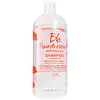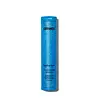What's inside
What's inside
 Key Ingredients
Key Ingredients

 Benefits
Benefits

 Concerns
Concerns

 Ingredients Side-by-side
Ingredients Side-by-side

Water
Skin ConditioningDisodium Laureth Sulfosuccinate
CleansingSodium Cocoyl Isethionate
CleansingSodium Lauryl Sulfoacetate
CleansingGlycerin
HumectantSodium Lauroyl Sarcosinate
CleansingCoco-Betaine
CleansingAcrylates Copolymer
Decyl Glucoside
CleansingButylene Glycol
HumectantLaureth-23
CleansingGlycol Distearate
EmollientGlycereth-26
HumectantVitis Vinifera Seed Oil
EmollientPrunus Amygdalus Dulcis Oil
Skin ConditioningMacadamia Integrifolia Seed Oil
Skin ConditioningCocos Nucifera Oil
MaskingGardenia Taitensis Flower Extract
Skin ConditioningArgania Spinosa Kernel Oil
EmollientCarthamus Tinctorius Seed Oil
MaskingSodium Hyaluronate
HumectantHydroxypropyltrimonium Hydrolyzed Corn Starch
Phenyl Trimethicone
Skin ConditioningPanthenyl Ethyl Ether
Magnesium Nitrate
Sodium PCA
HumectantPantethine
EmollientPolyquaternium-7
Polyquaternium-10
Sodium Acetate
BufferingIsopropyl Alcohol
SolventPotassium Hydroxide
BufferingLaureth-3
EmulsifyingTrisodium Sulfosuccinate
BufferingGlycol Stearate
EmollientSodium Chloride
MaskingSodium Sulfate
Parfum
MaskingLinalool
PerfumingHexyl Cinnamal
PerfumingTetrasodium EDTA
Sodium Citrate
BufferingPhenoxyethanol
PreservativeMethylchloroisothiazolinone
PreservativeMethylisothiazolinone
PreservativeSodium Benzoate
MaskingWater, Disodium Laureth Sulfosuccinate, Sodium Cocoyl Isethionate, Sodium Lauryl Sulfoacetate, Glycerin, Sodium Lauroyl Sarcosinate, Coco-Betaine, Acrylates Copolymer, Decyl Glucoside, Butylene Glycol, Laureth-23, Glycol Distearate, Glycereth-26, Vitis Vinifera Seed Oil, Prunus Amygdalus Dulcis Oil, Macadamia Integrifolia Seed Oil, Cocos Nucifera Oil, Gardenia Taitensis Flower Extract, Argania Spinosa Kernel Oil, Carthamus Tinctorius Seed Oil, Sodium Hyaluronate, Hydroxypropyltrimonium Hydrolyzed Corn Starch, Phenyl Trimethicone, Panthenyl Ethyl Ether, Magnesium Nitrate, Sodium PCA, Pantethine, Polyquaternium-7, Polyquaternium-10, Sodium Acetate, Isopropyl Alcohol, Potassium Hydroxide, Laureth-3, Trisodium Sulfosuccinate, Glycol Stearate, Sodium Chloride, Sodium Sulfate, Parfum, Linalool, Hexyl Cinnamal, Tetrasodium EDTA, Sodium Citrate, Phenoxyethanol, Methylchloroisothiazolinone, Methylisothiazolinone, Sodium Benzoate
Water
Skin ConditioningSodium Cocoyl Isethionate
CleansingCocamidopropyl Hydroxysultaine
CleansingCoco-Glucoside
CleansingGlycol Distearate
EmollientSqualane
EmollientHippophae Rhamnoides Fruit/Seed Oil
AntimicrobialBrassica Campestris Seed Oil
Skin ConditioningSesamum Indicum Seed Oil
EmollientCocos Nucifera Oil
MaskingSodium Hyaluronate
HumectantPolyglutamic Acid
Skin ConditioningSpirulina Platensis Extract
Skin ProtectingCocos Nucifera Water
MaskingEmblica Officinalis Fruit Extract
Skin ConditioningCurcuma Longa Root Extract
MaskingLeuconostoc/Radish Root Ferment Filtrate
AntimicrobialCocamide Mipa
EmulsifyingCoconut Acid
CleansingPolyester-11
Skin ConditioningGuar Hydroxypropyltrimonium Chloride
Skin ConditioningPolyquaternium-7
Polyquaternium-73
Sodium Methyl Cocoyl Taurate
CleansingTetrasodium Glutamate Diacetate
Sodium Benzoate
MaskingSodium Isethionate
CleansingSodium Hydroxide
BufferingSodium Chloride
MaskingCitric Acid
BufferingPotassium Sorbate
PreservativePhenoxyethanol
PreservativeParfum
MaskingBenzyl Benzoate
AntimicrobialHydroxycitronellal
PerfumingLimonene
PerfumingWater, Sodium Cocoyl Isethionate, Cocamidopropyl Hydroxysultaine, Coco-Glucoside, Glycol Distearate, Squalane, Hippophae Rhamnoides Fruit/Seed Oil, Brassica Campestris Seed Oil, Sesamum Indicum Seed Oil, Cocos Nucifera Oil, Sodium Hyaluronate, Polyglutamic Acid, Spirulina Platensis Extract, Cocos Nucifera Water, Emblica Officinalis Fruit Extract, Curcuma Longa Root Extract, Leuconostoc/Radish Root Ferment Filtrate, Cocamide Mipa, Coconut Acid, Polyester-11, Guar Hydroxypropyltrimonium Chloride, Polyquaternium-7, Polyquaternium-73, Sodium Methyl Cocoyl Taurate, Tetrasodium Glutamate Diacetate, Sodium Benzoate, Sodium Isethionate, Sodium Hydroxide, Sodium Chloride, Citric Acid, Potassium Sorbate, Phenoxyethanol, Parfum, Benzyl Benzoate, Hydroxycitronellal, Limonene
 Reviews
Reviews

Ingredients Explained
These ingredients are found in both products.
Ingredients higher up in an ingredient list are typically present in a larger amount.
Cocos Nucifera Oil is obtained from the kernels of the coconut fruit. In other words, this is coconut oil.
Coconut Oil is rich in fatty acids with lauric acid making up the majority of these. It also contains linoleic acid. Due to this high fatty acid content, coconut oil helps trap moisture and soften skin.
Despite being antibacterial, coconut oil may not be great for acne-prone skin. It is comedogenic and may clog pores. This ingredient may not be safe for malassezia or fungal acne.
Note: Coconut Oil should not replace your sunscreen for UV protection. Studies show it only blocks about 20% of UV.
This oil is non-volatile and has a light scent.
The term 'fragrance' is not regulated in many countries. In many cases, it is up to the brand to define this term. For instance, many brands choose to label themselves as "fragrance-free" because they are not using synthetic fragrances. However, their products may still contain ingredients such as essential oils that are considered a fragrance.
Learn more about Cocos Nucifera OilGlycol Distearate serves as a pearlizing or opacifying agent in cosmetic products.
It's often included in cleansers and haircare products to give them a lustrous or shimmering appearance.
It is derived from stearic acid, a natural fatty acid commonly found in vegetable oils and animal fats.
Glycol Distearate isn't fungal acne safe.
Learn more about Glycol DistearateParfum is a catch-all term for an ingredient or more that is used to give a scent to products.
Also called "fragrance", this ingredient can be a blend of hundreds of chemicals or plant oils. This means every product with "fragrance" or "parfum" in the ingredients list is a different mixture.
For instance, Habanolide is a proprietary trade name for a specific aroma chemical. When used as a fragrance ingredient in cosmetics, most aroma chemicals fall under the broad labeling category of “FRAGRANCE” or “PARFUM” according to EU and US regulations.
The term 'parfum' or 'fragrance' is not regulated in many countries. In many cases, it is up to the brand to define this term.
For instance, many brands choose to label themselves as "fragrance-free" because they are not using synthetic fragrances. However, their products may still contain ingredients such as essential oils that are considered a fragrance by INCI standards.
One example is Calendula flower extract. Calendula is an essential oil that still imparts a scent or 'fragrance'.
Depending on the blend, the ingredients in the mixture can cause allergies and sensitivities on the skin. Some ingredients that are known EU allergens include linalool and citronellol.
Parfum can also be used to mask or cover an unpleasant scent.
The bottom line is: not all fragrances/parfum/ingredients are created equally. If you are worried about fragrances, we recommend taking a closer look at an ingredient. And of course, we always recommend speaking with a professional.
Learn more about ParfumPhenoxyethanol is a preservative that has germicide, antimicrobial, and aromatic properties. Studies show that phenoxyethanol can prevent microbial growth. By itself, it has a scent that is similar to that of a rose.
It's often used in formulations along with Caprylyl Glycol to preserve the shelf life of products.
Polyquaternium-7 is a light to clear colored liquid. It is commonly found in haircare products for its film-forming and anti-static properties.
According to a manufacturer, it is a non-paraben and specially developed for negatively charged surfactant systems. This makes it a great hairstyle holder and helps to improve wet hair detangling without adding buildup.
Sodium Benzoate is a preservative. It's used in both cosmetic and food products to inhibit the growth of mold and bacteria. It is typically produced synthetically.
Both the US FDA and EU Health Committee have approved the use of sodium benzoate. In the US, levels of 0.1% (of the total product) are allowed.
Sodium benzoate works as a preservative by inhibiting the growth of bacteria inside of cells. It prevents the cell from fermenting a type of sugar using an enzyme called phosphofructokinase.
It is the salt of benzoic acid. Foods containing sodium benzoate include soda, salad dressings, condiments, fruit juices, wines, and snack foods.
Studies for using ascorbic acid and sodium benzoate in cosmetics are lacking, especially in skincare routines with multiple steps.
We always recommend speaking with a professional, such as a dermatologist, if you have any concerns.
Learn more about Sodium BenzoateChances are, you eat sodium chloride every day. Sodium Chloride is also known as table salt.
This ingredient has many purposes in skincare: thickener, emulsifier, and exfoliator.
You'll most likely find this ingredient in cleansers where it is used to create a gel-like texture. As an emulsifier, it also prevents ingredients from separating.
There is much debate on whether this ingredient is comedogenic. The short answer - comedogenic ratings don't tell the whole story. Learn more about comegodenic ratings here.
The concensus about this ingredient causing acne seems to be divided. Research is needed to understand if this ingredient does cause acne.
Scrubs may use salt as the primary exfoliating ingredient.
Learn more about Sodium ChlorideSodium cocoyl isethionate is a natural ingredient from coconut oil. It is an ultra gentle cleanser that gives a nice foam without drying the skin or impacting the skin barrier.
The amount of foam created depends on the amount of sodium cocoyl isethionate used in the product.
This ingredient also helps improve the spreadability of a product.
Learn more about Sodium Cocoyl IsethionateSodium Hyaluronate is hyaluronic acid's salt form. It is commonly derived from the sodium salt of hyaluronic acid.
Like hyaluronic acid, it is great at holding water and acts as a humectant. This makes it a great skin hydrating ingredient.
Sodium Hyaluronate is naturally occurring in our bodies and is mostly found in eye fluid and joints.
These are some other common types of Hyaluronic Acid:
Learn more about Sodium HyaluronateWater. It's the most common cosmetic ingredient of all. You'll usually see it at the top of ingredient lists, meaning that it makes up the largest part of the product.
So why is it so popular? Water most often acts as a solvent - this means that it helps dissolve other ingredients into the formulation.
You'll also recognize water as that liquid we all need to stay alive. If you see this, drink a glass of water. Stay hydrated!
Learn more about Water